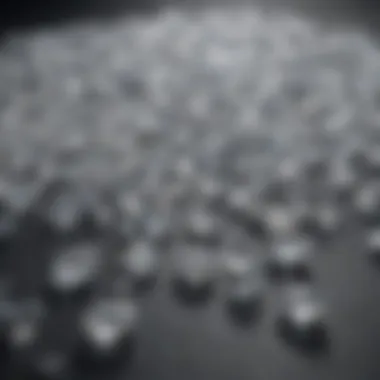Exploring White Stones: Their Names, Properties, and Uses


Intro
The realm of gemstones and minerals is vast and intriguing, encapsulating endless stories told through the ages. White stones, with their stunning clarity and brilliance, stand out in this captivating world. From shimmering diamonds to the soft, ethereal hue of moonstone, each white stone comes with its own tale. This guide serves as your roadmap through that story, navigating the intricate features, historical significance, and diverse applications of these precious materials.
Whether you're a seasoned collector or just dipping your toes into the world of geology and jewelry design, the allure of white stones is hard to resist. Each rock holds a whisper of its geological journey, and understanding these stones opens doors to deeper appreciation and insights. As we venture through this comprehensive exploration, you'll discover not only the distinct names of various white stones but also their properties and how they have found their place in both the artistic and scientific realms.
Prolusion to White Stones
White stones, a fairly diverse category within the gem and mineral world, serve numerous roles across various fields. From aesthetic appeal in jewelry to specific applications in construction and holistic practices, the significance of these stones is far-reaching. They not only captivate the eye but also hold rich histories and properties that are worth exploring.
The importance of understanding white stones lies in their multifaceted nature. For gemstone enthusiasts and collectors, each stone has its own unique story and attributes. Jewelry designers can leverage the subtlety and elegance of these stones to create exquisite pieces. Geologists and students of earth sciences benefit from examining the formation, distribution, and characteristics of these materials that are often overlooked.
Furthermore, the exploration of white stones can enhance one’s appreciation for the natural world. When delving into the various types available, one might uncover a profound connection to nature’s artistry.
"White stones reflect not just light, but a legacy of Earth’s history and artistry."
To appreciate white stones fully, one must understand how they are defined and how historical contexts shape our perception of their value. As the article unfolds, readers will embark on a journey through definitions, classifications, and intriguing historical anecdotes that reveal their significance. Emphasizing both beauty and utility, this guide aims to highlight the invaluable contributions of white stones to our lives.
Classification of White Stones
Understanding the Classification of White Stones is vital for anyone interested in gemstones, whether you're a seasoned collector, a jewelry designer, or just someone who appreciates the beauty of minerals. Classifying these white stones provides a framework to identify, evaluate, and categorize them based on various criteria. This not only streamlines the research process but also ensures clarity when navigating their numerous properties and applications. In essence, this classification helps demystify the complexities surrounding white stones, making the knowledge more accessible and applicable for enthusiasts.
Mineral Composition
The mineral composition of white stones is central to their classification. Each stone's unique chemical makeup dictates not only its appearance but also its durability and potential uses. For example, calcite is a common white mineral, primarily composed of calcium carbonate. This composition gives it a characteristic crystalline structure, making it popular in various industrial applications.
- Mechanical Properties: Some minerals, like quartz, exhibit exceptional hardness due to their silica content, which influences their use in construction and jewelry.
- Optical Properties: The nature of the mineral composition affects how light interacts with the stone. This property is particularly crucial in gemstones, where brilliance and luster can dramatically affect their market value.
It’s noteworthy that impurities in a stone’s composition can lead to exciting variations, transforming the appearance of otherwise standard white stones into unique specimens. For instance, the presence of other elements can slightly tint a white gemstone, creating distinct color varieties.
Geological Distribution
Understanding the geological distribution of white stones helps locate where these minerals can commonly be found. White stones are formed under specific environmental conditions, and their availability often correlates with certain geographical regions. For instance:
- Marble: Predominantly found in places like Carrara, Italy, this metamorphic rock forms from limestone under high temperature and pressure. It has been craved for centuries for its beauty in sculptures and buildings.
- Gypsum: This evaporite mineral is abundant in desert regions, forming through evaporating seawater, which leaves behind a crystallized substance suitable for various industrial uses.
- Opal: Found mostly in Australia, opal's distribution is tied to the geographical past of the region, where volcanic activity played a crucial role in its formation.
The geological context not only informs us about a stone's rarity but can also provide insights into its historical significance and potential economic value in various trades.
By examining both mineral composition and geological distribution, enthusiasts gain invaluable knowledge about the classification of white stones, enabling deeper appreciation and informed decision-making in gemstone selection.
Popular White Gemstones
White gemstones hold a special place in both the jeweler's toolkit and the earth's geological story. They dazzle with their brilliance, shimmer with their unique light refraction, and feel significant whether embedded in a wedding ring or displayed as a collector's item. Understanding these popular white gemstones can deepen one’s appreciation and knowledge of their intrinsic value and multifaceted uses.
Diamond
Properties and Characteristics
Diamonds are renowned for their unrivaled hardness and scintillating brilliance. One standout quality is their exceptional ability to refract light, which creates the iconic sparkle associated with this stone. A diamond's clarity, cut, and carat greatly influence its value. The sheer resilience of diamonds makes them an enduring choice for jewelry, appealing to those who seek beauty and strength in every facet.


However, its ideal traits can sometimes overshadow the fact that diamonds are often sought from controversial sources, raising ethical queries about their procurement.
Uses in Jewelry and Industry
In the world of jewelry, diamonds take center stage. They are not just symbols of love and commitment but also magnificent accessories for special occasions. From engagement rings to ornate pendants, diamonds transform wearers into showstoppers. Beyond aesthetics, diamonds also play a crucial role in various industries. Their hardness is unmatched, making them essential in cutting, grinding, and drilling tools. Yet, the debate regarding their ethical sourcing remains a critical consideration for conscious buyers.
White Sapphire
Distinctive Features
White sapphires charm with their elegance and clarity that can rival diamonds. Less expensive compared to diamonds, they offer a stunning brilliance without breaking bank. Their durability comes close to that of diamonds, making them a practical option in jewelry.
Sapphires, although seen as substitutes for diamonds, carry their own essence and beauty. A unique feature is their natural color variations, which cater to those who prefer a less conventional choice without sacrificing elegance.
Applications in Design
From rings to bracelets, white sapphires are versatile stones in the realm of jewelry design. Jewelers favor them for their strength and reliability. They can be found in fashion-forward pieces or classic designs alike, making them appealing across demographics. Their adaptability means they can be paired with other gemstones, offering unlimited creative potential. Yet, some may see them simply as a lesser option compared to diamonds.
Opal
Formation and Variants
Opals are fascinating due to their color play – a phenomenon that causes them to shift colors as light hits their surface. They are formed from silica gel, creating structures that allow for this mesmerizing effect. Each opal possesses a unique pattern that tells a story of its origin.
However, their delicate nature needs careful handling, making them somewhat of a double-edged sword for collectors and jewelers alike.
Metaphysical Properties
Many believe opals possess metaphysical properties, enhancing creativity and stimulating imagination. These stones are often associated with emotional healing, making them popular among holistic practitioners. Their ethereal presence can evoke peace and inspiration, but skeptics question the lack of empirical evidence supporting these claims.
Moonstone
Glimmer and Luster
Moonstones are celebrated for their adularescence, a soft light that seems to float just below the surface. This enchanting effect gives them an otherworldly appearance. Their shimmering luster enriches any jewelry piece, bringing an aura of mystery. Yet, they require gentle care; their softness makes them susceptible to scratches.
Role in Cultural Practices
Moonstone carries significance in various cultures, often regarded as a stone of new beginnings. It has been cherished by many cultures for centuries for its ability to enhance intuition and provide emotional balance. Even so, the cultural context can sometimes diverge greatly, leading to misunderstandings about its value or role in different traditions.
Howlite
Identifying Features
Howlite is known for its unique look; its white surface is veined with gray or black. It often resembles turquoise, making it a popular choice for both jewelry and home decor. This affordability and lightweight composition make it appealing for larger items without hefty price tags. However, one must be cautious, as its porous nature means it can easily stain.
Importance in Healing
On the healing side, many advocate for howlite's calming properties. It's often used in meditation practices and believed to facilitate restful sleep. Owning howlite can be comforting and supportive, but the empirical claims about its healing powers lack scientific backing, leaving this stone straddling the line between belief and skepticism.
"White gemstones do not just add elegance; they carry stories of the earth and human culture. "


Other Notable White Minerals
White minerals extend beyond the sparkle of gemstones; they form the foundation of many architectural and industrial applications. Often overlooked, minerals such as marble and calcite add significant value for their unique attributes. Understanding these white minerals deepens our appreciation of their varied roles and practical uses, establishing their importance in both historical and contemporary contexts.
Marble
Uses in Architecture
Marble has been a cherished material in architecture for centuries. Its durability and beauty make it a preferred choice for iconic structures and intricate design elements. This stone, often associated with elegance, is commonly used in flooring, countertops, and sculptures. The key characteristic of marble is its capacity to be polished to a high sheen, which enhances its visual appeal, making it particularly beneficial for aesthetic purposes.
One of the unique features of marble is its availability in various colors, despite its classification as a white stone. This variety provides architects and designers the flexibility to choose according to specific project needs, contributing significantly to the overall architectural splendor.
However, there are disadvantages to consider. Marble is porous, meaning it can stain easily if not maintained properly. This aspect necessitates extra care, especially in spaces prone to spills or heavy foot traffic.
Historical Context
The historical significance of marble is profound. It has been utilized since ancient times, seen in masterpieces like the Parthenon and Michelangelo’s David. This stone’s historical context reveals its role not just in construction but as a canvas for artistry. Marble became synonymous with power and wealth, often used in the homes of the elite and in public monuments.
The key characteristic of marble’s enduring popularity is its symbolism. It conveys sturdiness and luxury, making it a popular ingredient in the crafting of impressive structures. A unique feature of marble’s historical narrative is its adaptability; it has been sculpted from monolithic forms into detailed architectural elements, showcasing both strength and delicacy. The main disadvantage here, however, lies in its extraction; mining can be environmentally taxing and less sustainable.
Calcite
Varieties and Properties
Calcite is another prominent white mineral, admired for its several varieties and distinctive properties. This mineral occurs in various forms, such as Iceland spar and chalk, with each variant possessing unique characteristics. The transparency of Iceland spar and its double refraction effect is particularly notable, making it a fascinating specimen for mineral collectors and enthusiasts. What makes calcite beneficial is its wide range of uses in both ornamental and functional capacities.
Calcite’s unique feature is its ability to fluoresce, which can add an interesting dynamic to mineral displays and collections. The varieties of calcite also allow for differing applications, from decorative pieces to essential materials in various industries. However, its softer nature makes it susceptible to scratching, limiting its use in some high-wear environments.
Its Role in Industry
Calcite plays a crucial role in multiple industries. It is extensively used in the production of lime and cement, foundational materials in construction. In agriculture, calcite serves as a soil conditioner and pH stabilizer. This function highlights its importance in enhancing crop productivity. The key characteristic that makes calcite a winning choice in these fields is its abundance—it’s one of the most easily accessible minerals in the crust.
Moreover, calcite's versatility also extends to its applications in the plastics and paint industries, where it acts as a filler. This unique feature of calcite not only provides performance benefits but also contributes to cost savings in production processes. However, its reliance on mining practices puts it in the spotlight concerning sustainability, prompting a broader conversation about responsible sourcing.
Calcite, with its multifaceted roles, epitomizes the balance between natural beauty and industrial utility.
The Importance of Color in Gemology
In the realm of gemology, color is not just an aesthetic appeal; it plays a crucial role in determining the value, desirability, and even the perceived meaning of each stone. White stones, too, embody a fascinating narrative about color perception and its implications in various contexts. Understanding how color influences gemology enhances appreciation for these natural wonders, and it provides insight into market trends, buyer preferences, and cultural significance.
Factors Influencing Color
Light Reflection and Refraction
Light reflection and refraction are fundamental in how we perceive color in gemstones. When light strikes a stone, it either bounces off or passes through, bending at angles that create vibrancy or dullness. This characteristic is crucial for white stones, as they often rely much on clarity and brilliance. For instance, a well-cut white diamond will refract light beautifully, showcasing a sparkling quality that draws the eye.
However, not all reflections are equally appealing—overly cloudy or poorly cut stones can appear lifeless. Thus, the inherent cut quality is vital to achieving that desirable dazzlement. Refraction enhances the unique beauty of a gemstone. Yet, it can also make a stone's clarity harder to assess at a glance. Investing in quality cut stones can therefore be beneficial in achieving visual brilliance for consumers who seek those striking looks.
Impurities and Enhancements
Every gemstone is unique, often influenced by impurities. In the case of white stones, this might occasionally lead to distinctive coloring or patterns. Impurities can create subtle hinting shades like creamy whites in opals or faint hues in moonstones. Enhancements can sometimes improve these imperfections, making the stone more aesthetically appealing and valuable in the market.


However, reliance on enhancements poses its pitfalls. Consumers may find themselves questioning the authenticity or longevity of treated stones. Knowing how these features relate to value is essential for collectors or investors aiming to make sound decisions. While these treatments can bring out the best in a stone, it can also lead to overhyped valuations. Therefore, it’s prudent for buyers to maintain a critical eye on both natural and enhanced stones.
Cultural Perceptions
The Symbolism of White
White stones are often imbued with rich symbolism, representing purity, peace, and clarity in various cultures. For many, the color white signifies a fresh start or a blank slate. This symbolism finds its way into the marketing strategies of jewelers, who often highlight these meanings when presenting white gemstones. In Holistic practices, for the like of Howlite, this symbolism extends to spiritual purity and calmness, making it a sought-after stone for those looking for balance in life.
However, the cultural interpretations of white can differ dramatically around the world. For instance, while white symbolizes purity in many Western cultures, it can connote mourning in some Eastern traditions. Therefore, understanding this symbolism provides deeper insights into the cultural dynamics surrounding the appreciation and use of white stones.
Regional Variations in Meaning
Regional variations in the perception of white gemstones can significantly influence their desirability and value. For example, in certain cultures, white is associated with opulence, while in others, it may be tied solely to spirituality or healing properties. Such divergent meanings can create a regional demand for specific stones over others.
Delving into these cultural nuances can be enlightening for enthusiasts and collectors, guiding their choices based on informed preferences rather than trends alone. Moreover, this awareness encourages appreciation for how different communities interact with the same white stones in various ways. Such insights help explain fluctuating market values and highlight the diverse roles these stones play in human experiences.
The significance of color in gemology is not to be understated; it is an intricate web interwoven within our cultural fabric, economic decisions, and aesthetic choices.
Caring for White Stones
White stones hold not only aesthetic value but also sentimental and, in some cases, monetary worth. Consequently, understanding how to properly care for these gems is paramount for anyone deeply engaged with them—be it collectors, enthusiasts or jewelry designers. The brilliance and elegance of white stones can fade without proper handling and maintenance. So, let’s draw back the curtain on aspects like cleaning and storing methods that will help maintain their radiance for years to come.
Cleaning Techniques
The key to keeping white stones in top shape is routine cleaning. Each gemstone or mineral requires a different approach, and knowing the specifics is crucial. Here are some effective cleaning techniques:
- Gentle Soap and Warm Water: For many white gemstones, including diamonds and opals, a mixture of mild soap with warm water works wonders. Simply soak, then gently scrub with a soft-bristle toothbrush. Rinse thoroughly and pat dry with a lint-free cloth.
- Ultrasonic Cleaners: For hard stones like white sapphires and diamonds, ultrasonic cleaners can be an efficient option. Always check if your stone can withstand such treatment, as not all can.
- Avoiding Harsh Chemicals: Never use bleach or ammoniated solutions; they can dull the stone's lustre and ruin its clarity. It's advisable to stick to natural solutions.
It's also worth noting that certain stones have unique properties that might require crafting a bespoke cleaning method. For instance, moonstone is softer and should be treated with extra care, using just water.
"Regular cleaning is akin to giving your stones a refreshing spa day; they shine brighter with each session."
Storing White Gemstones
Proper storage of your white stones is equally crucial to preserve their beauty. Investing in optimal storage solutions protects your gems from scratches, environmental effects, and other potential damage.
- Soft Pouches and Cases: Store individual precious stones in soft pouches. Avoid placing them all in one box; mixing them can lead to scratches. Hard cases lined with softer materials serve as an excellent choice too.
- Temperature and Humidity Control: High humidity can lead to mold in some stones like howlite. Ideally, gemstones should be kept in a stable environment away from direct sunlight, which can cause some stones to fade over time.
- Organizational Displays: If you're displaying your stones, consider using a glass-covered display case. This keeps dust at bay while allowing you to enjoy the view.
- Regular Checks: Every now and then, review your collection. This helps you spot any early signs of damage or wear that you can address promptly.
Closure
In this ongoing journey through the realm of white stones, we have uncovered not just their inherent beauty but also their immense value across multiple domains. Each section has added a tantalizing layer to our understanding, demonstrating how diverse these stones can be—from their geological origins to their roles in jewelry and healing arts. The conclusion serves as a mirror reflecting the entire article back to the reader, emphasizing the intricate relationship between these stones and their various aspects.
Recap of White Stones' Value
The varied uses of white stones illustrate their significance far beyond mere aesthetics. They are not just beautiful decorations; they also possess practical applications. For example, diamonds and white sapphires have made their mark in fine jewelry, while substances like calcite serve vital roles in industrial processes. Additionally, the metaphysical properties associated with stones like opal and howlite offer holistic benefits that resonate deeply within certain communities. These contexts reveal that white stones carry a dual identity, serving both functional and spiritual purposes.
"White stones are a bridge between nature and our lives, showcasing the harmony between beauty and utility."
Moreover, the historical context of these stones shows how they have been cherished through ages, often embodying cultural beliefs and practices that connect people across generations. Thus, the value of white stones is not just in their composition but also in how they tie into human experiences and histories.
Encouragement for Continued Exploration
As one explores the multifaceted nature of white stones, the invitation to further inquiry becomes clearer. It encourages enthusiasts, collectors, and professionals alike to delve deeper into materials that captivate their imagination. Whether one is drawn to the sparkling allure of moonstone or the robust characteristics of marble, there is always more to uncover—stories waiting to be told, connections to be made.
Engaging with white stones doesn't have to end here. Consider attending gem shows, where you can hold various specimens and learn from experts. Books on mineralogy or gemology can shed light on nuances that the casual observer might miss. There are also vibrant communities on platforms like Reddit or Facebook, where fellow enthusiasts share their findings and insights.
In the end, knowledge about white stones is not merely academic. It’s a pursuit that fuels passion and creativity, potentially leading to new discoveries and enriching experiences. So, venture forward, explore, and let the world of white stones beckon you to unveil their hidden treasures.







